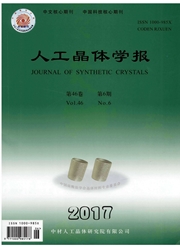

 中文摘要:
中文摘要:
分析了4种不同工艺制备的石英玻璃在紫外区和红外区的光谱特征,测量了不同温度下石英玻璃的交流电学阻抗响应。结果表明,4种石英玻璃的体电阻和弛豫时间与温度的关系均符合Arrhenius方程,表明其电导具有热激活特征。同时,不同温度时复平面阻抗曲线及其介电模量频谱曲线,均反映这些石英玻璃各自呈现单一导电机制,但其激活能差别明显:电熔石英玻璃样品SG1和SG2的电导激活能分别为1.002和1.384 e V,合成石英玻璃样品SG3和SG4的电导激活能分别为1.458和0.520 e V。激活能的数值不仅与石英玻璃的导电类型相关,也与石英玻璃中金属杂质含量、氧缺陷浓度及羟基含量密切相关。
 英文摘要:
英文摘要:
The contents of metal impurities, hydroxyl and oxygen defects of 4 types of silica glasses were analyzed based on their ultraviolet and infrared absorption spectra. Their temperature-dependent behaviors of electrical impedance were recorded. The results show that the bulk resistance and relaxation time of the silica glasses are consistent well with the Arrhenius equation, indicating that the conductivity is a thermally activated process. The frequency-dependent spectra of the complex impedance and the electric modulus at different temperatures indicate the single mechanism for the dynamic processes in these four types of silica glasses. However, their activation energies present a great difference: the activation energies of electrically-fused quartz glass samples SG1 and SG2 are 1.002 and 1.384 eV, respectively, while the activation energies of synthetic quartz glass samples SG3 and SG4 are 1.458 eV and 0.520 eV, respectively. It is assumed that the change in activation energy could be related to the conduction mechanism and the contents of metal impurity, hydroxyl and oxygen defects in the silica glasses.
 同期刊论文项目
同期刊论文项目
 同项目期刊论文
同项目期刊论文
 Effect of sintering temperature on internal-bias field and electric properties of 0.2PZN-0.8PZT cera
Effect of sintering temperature on internal-bias field and electric properties of 0.2PZN-0.8PZT cera Relaxation mechanism analysis of synthetic fused quartz glass investigated by electrical impedance s
Relaxation mechanism analysis of synthetic fused quartz glass investigated by electrical impedance s Comparative study of microstructure, electric properties and conductivity for NiO and PNN modified P
Comparative study of microstructure, electric properties and conductivity for NiO and PNN modified P Origin of Relaxor Behavior in K1/2Bi1/2TiO3–Bi(Mg1/2Ti1/2)O3 Investigated by Electrical Impedance Sp
Origin of Relaxor Behavior in K1/2Bi1/2TiO3–Bi(Mg1/2Ti1/2)O3 Investigated by Electrical Impedance Sp Investigation on microstructure and electrical properties of CuAl1-xYxO2 ceramics by electrical impe
Investigation on microstructure and electrical properties of CuAl1-xYxO2 ceramics by electrical impe Effect of NiO additive on microstructure, mechanical behavior and electrical properties of 0.2PZN-0.
Effect of NiO additive on microstructure, mechanical behavior and electrical properties of 0.2PZN-0. 期刊信息
期刊信息
